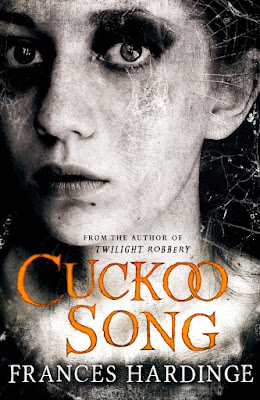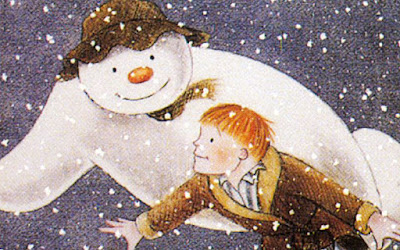by Addy Farmer
About two minutes ago, the Summer Holidays stretched out like this ... |
| not a computer in sight |
 |
| Moominpapa could write whenever he wanted to |
Never mind because in the end reading is the stuff of writing.
The media would have us think that Summer is a time for reading and I did read alot although not on the beach. But I don't think that I read anymore than I do the rest of the year. Radio 4 even had a brief say about how summer reading was no different to winter reading on the daily commute, really. Most of my summer reading has been a writer new to me, Frances Hardinge. I whipped through the brilliant, 'Verdigris Deep' and 'The Lie Tree' and 'Cuckoo Song'. I've just started, 'A Face of Glass'. These are cracking good stories and that is what I like to read any time of the year.
But I do like Winter and stories set in winter time. So, let's just conveniently forget the intervening hufflepuff-like season of Autumn and spring to contemplation of Winter stories. Is there a difference between these and those set in Summer? Perhaps, we might personify them. Summer is perky with arms-wide and smiling where Winter is dark, hunched and dour. One camps outdoors, one skulks inside. One looks out at the world, the other looks inwards ... well, you get the idea.
Winter is coming (say it like a cinema trailer announcement). Put that way, it sounds scary which to my mind is not a bad thing. Traditionally, Winter is associated with death and hibernation. It is when the flowers fold and the garden hides. The cold makes your fingers freeze and your bones ache; it requires effort to keep warm and keep moving.
 |
| Hope you're wearing a vest, Gandalf |
SNOW!
Winter Time by Robert Louis Stevenson
Close by the jolly fire I sit
To warm my frozen bones a bit;
Or with a reindeer-sled, explore
The colder countries round the door.
When to go out, my nurse doth wrap
Me in my comforter and cap;
The cold wind burns my face, and blows
Its frosty pepper up my nose.
Black are my steps on silver sod;
Thick blows my frosty breath abroad;
And tree and house, and hill and lake,
Are frosted like a wedding cake.
Here, in A Child's Garden of Verses, Stevenson sums up all the good stuff I used to love as a child about Winter. it could be the comfort of playing outside on a snapping-cold day, then the glorious comfort of warming yourself, not to mention the breath-taking beauty of a landscape transformed by SNOW.
 |
| Where the dickens did all this snow come from?! |
" The darkness and the mist had vanished with it, for it was a clear, cold winter day, with snow upon the ground ... the quick wheels dashing the hoar-frost and snow from off the dark leaves of the evergreens like spray"
I like that C.S Lewis added a touch of Victorian London to Narnia. Not only that but the snow makes it beautiful. I want to go there. The snow plays a more sinister role here; it is seen as stilling time and freezes life to its essentials. The land waits for Winter to end (spoiler - it does).
 |
| RUN! |
 |
| Mad as a box of frogs |
 |
| She looks almost cuddly |
 |
do not cuddle this bear |
 |
| The best cover in the world |
I'm gonna sit here in my place on the hill behind the house. Waiting. And watching. Ain't nothing moving down there. The valley look pretty bare in the snow. Just the house grey and lonely down by the river all frozen.The snow can force you inside and send you mad or make you see things that might or might not be there. It is the perfect setting for a ghost story as Dark Matter by Michele Paver so brilliantly and shiveringly demonstrates. The snow blinds the hero, Jack. “How odd, that light should prevent one from seeing.” he says. The snow controls his movements and eventually his mind and makes him see what should not be there. In the end, the snow subdues him.
Ah, but it's not all teen-angst gloom and doom. At the younger end, there are so many ways for snow to be the cheery, comforting, exciting and playful.
Summer fading, winter comes
Frosty mornings, tingling thumbs,
Window robins, winter rooks,
And the picture story-books.
Picture Books in Winter by Robert Louis Stevenson
 |
| Come in! It's lovely and warm inside! |
Bear and Hare:Snow! by Emily Gravett celebrates the joy to be had with friends in the snow.
 |
| We've all done it |
.... before the warmth of friendship found and all wrapped up in Christmas - lovely.
I leave the obvious to last and I'll whisper it, Christmas. It seems that no Christmas is complete without snow. I agree. I want Christmas to have deep and crisp and even snow ...
so we can make snowmen.
So never mind that it's the end of Summer, Winter is coming and it brings ...

















As a teacher, I loved reading your reccommendations! I can’t wait to find the Groundhog’s day book you suggested at the top. It’s always a fun holiday to celebrate because, frankly, we’re all just looking for something fun to celebrate between Christmas and Easter! Thanks!
You’re very welcome! It does seem as if spring is far away, doesn’t it? I’d love to hear how this goes over with your students.